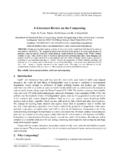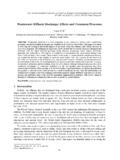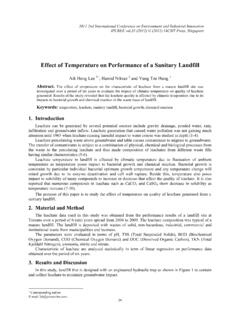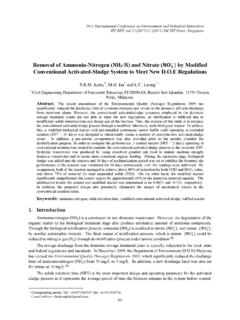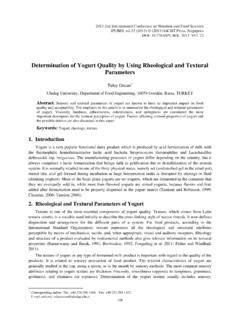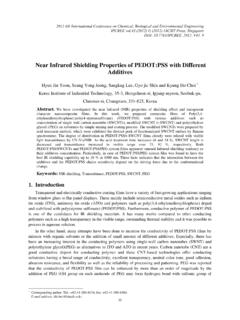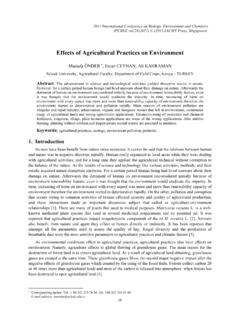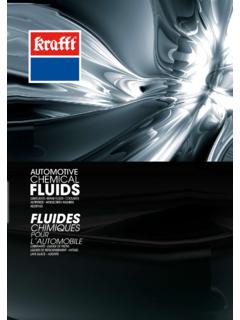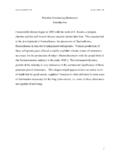Transcription of Application of Diagnostic Ratios of PAHs to Characterize ...
1 Application of Diagnostic Ratios of PAHs to Characterize the pollution Emission Sources Marek Tobiszewski Department of Analytical Chemistry, Chemical Faculty, Gda sk University of Technology (GUT), ul. G. Narutowicza 11/12, 80-233 Gda sk, Poland Abstract. The paper summarizes the potential of Application of parent polycyclic aromatic hydrocarbons (PAHs) to identify their emission sources. Four parent PAHs Diagnostic Ratios are used for this purpose: anthracene/(anthracene + phenanthrene), fluoranthene/(fluoranthene + pyrene), benzo[a]pyrene /(benzo[a]pyrene + chryzene) and indeno[1,2,3-c,d]pyrene/(indeno[1,2,3-c, d]pyrene + benzo[g,h,i]perylene). The compounds of each ratio have the same molar mass and similar physicochemical parameters, so they are characterized by similar environmental fate. Thus, the Ratios ideally remain constant from the moment of emission to sample collection and analysis. The Ratios allow to identify PAHs emissions from unburned petroleum, petroleum combustion and biomass burning.
2 The example of Application to surface water samples is presented. Keywords: Polycyclic aromatic hydrocarbons, molecular markers, organic pollutants. 1. Introduction Polycyclic aromatic hydrocarbons (PAHs) are group of environmental pollutants of special concern. They are mutagenic, toxic and carcinogenic [1]. PAHs originate from natural processes, like bush fires, volcanic eruptions or diagenesis [2] but they also come from anthropogenic emission sources, like combustion of liquid petroleum fuels [3], biomass [4] and coal [5]. They are found in crude oil and petroleum based fuels, therefore they can be emitted to the environment during spills of petroleum containing products [6]. PAHs are emitted and found in the environment as a mixture of pollutants from this group. PAHs emission profile from unburned fuel is characterised by the domination of light, two and three ring PAHs, whereas PAHs emission profile from burning processes is characterised by the domination of four and five ring PAHs.
3 Compared to combustion PAHs, petroleum related PAHs are characterised by higher content of alkyl substituted derivatives [7]. PAHs emitted to the environment undergo degradation and may be transferred to other phases. Therefore source characteristic PAH emission profiles can be altered during PAH environmental fate. To minimize the changes of PAH profile after emission to the environment, instead of taking into consideration the whole profile, the ratio of just two compounds is calculated. These compounds have the same molar mass, so their physicochemical parameters water solubility, vapour pressure, lipophilicity, sorption coefficients are also similar [8]. Thus, the relative ratio of the two isomers ideally remains constant from the moment of emission to the sample collection. The aim of the study is to determine the sources of PAHs in surface water samples, collected in the Gda sk region. Applicability of PAH Diagnostic Ratios to surface water samples will be evaluated.
4 2. Application of Diagnostic Ratios The characteristic values of PAH Diagnostic Ratios [9] based on parent PAHs are presented in the Table 1. They allow to distinguish between PAH pollution originating from petrogenic (liquid fuels spills), pyrolytic (combustion of fuels) and burning biomass or coal sources. 2014 5th International Conference on Environmental Science and Technology IPCBEE (2014) (2014) IACSIT Press, Singapore DOI: 2014. V69. 9 41 Table 1: Characteristic Diagnostic Ratios values for particular pollution emission sources. Diagnostic ratio Petrogenic Fuel combustion Coal, grass, wood burning ANT/(ANT + PHE) < > - FLA/(FLA + PYR) < > BaA/(BaA + CHR) < > IcdP/(IcdP + BghiP) < > ANT anthracene; BaA benzo[a]anthracene; BghiP benzo(ghi)pyrene; CHR chrysene; FLA fluoranthene; IcdP indeno(cd)perylene; PHE phenanthrene; PYR pyrene. PAH Diagnostic Ratios can be applied to water samples. They have been successfully applied to identify the river sections influenced by biomass burning processes, traffic related emissions and effluent from petrochemical industry wastewater treatment plant [10].
5 Analysis of bottom sediments allows to assess the range of oil spills, as well as the rates of oil weathering processes [11]. To identify the emission sources of PAHs, affecting the quality of sediments, the analysis of mussel tissues are applied, instead of sediment analysis [12]. The analysis of PAHs present in sediment cores, together with sediment dating, gives information on historical activities of particular PAH sources. Shifts from wood burning, to coal and coke utilization and oil combustion as main energy sources were identified [13]. Other study showed shift from softwood burning to petroleum combustion as the sources of bottom sediment PAH pollution [14]. 3. Materials & Methods Samples were collected along surface water stream in five sampling points numbered from 1 to 5. Sampling point 1 is not in the very close neighborhood of any emission source, sampling point 2 is near to discharge from industrial facility, while sampling points 3, 4 and 5 are located next to road.
6 Isolation and enrichment of PAHs was performed by SPE. The cartridges were filled with LiChrolut RP 18 sorbent and were conditioned with 3 ml of dichloromethane, 2 3 ml of methanol and 3 ml of deionized water. Then the 200 ml of the samples, with flow rate 2 ml min-1, were passed through the SPE cartridges and were dried in the air for 30 min. Next, the analytes were eluted with 4 2 ml of dichloromethane and the solvent was evaporated under nitrogen stream. For PAHs determination, the sample was filled with 1 ml of dichloromethane. The extracts were stored in the dark vials in the temperature of 4 C. The final determination of PAHs was done using gas chromatography coupled with mass spectrometry. The chromatograph was equipped with on-column injector, column 30 m mm with Rtx-5MS stationary phase of film thickness mm. Temperature program started at 40 C, raised to 120 C at rate 40 Cmin-1, then to 280 C at rate 5 C min-1.
7 The detector used was Agilent Technologies 5975C with electron ionization, working in the SIM mode. Helium was used as a carrier gas. External standard method was applied for quantitative analysis, the lower detection limits were established to be in range from to ng dm-3. 4. Results & Discussion PAHs determined in the samples were within sub- g dm-3 levels. Generally, light PAHs were determined in the water samples, because of their higher solubility in water than heavier PAHs. Application of ANT/(ANT + PHE) was not possilble as ANT was below the detection limit, although PHE was quantified in the majority samples. ANT is usually present at lower concentrations than PHE for pyrogenic and petrogenic processes. Both IcdP and BghiP were not detected in the samples, similarly to BaA and CHR. The presence of these compounds is considered to be characteristic for combustion processes. FLA/(FLA/PYR) ratio is robust to changes during phase transfer and degradation in the environment.
8 Therefore FLA/(FLA + PYR) ratio seems to be more reliable to assess the pollution emission sources. The results of these Diagnostic Ratios calculation are presented in the Table 2. 42 Table 2: The concentations of fluoranthene, pyrene and FLU/(FLU+PYR) values FLU [ng L-1] PYR [ng L-1] FLU/(FLU+PYR) A1 A2 A3 A4 A5 B1 B2 B3 B4 B5 C1 C2 C3 C4 C5 D1 D2 D3 D4 D5 E1 E2 E3 E4 E5 F1 F2 F3 F4 G1 G2 G3 G4 The results of FLA/(FLA + PYR) ratio show that PAHs in the most of the samples collected in sampling point 1 originate from biomass or coal burning. The concentrations of PAHs in samples collected in sampling point 1 are the lowest as it is not under direct influence of any emission source. Therefore this sampling point can be treated as indicator of background concentration level and the background emission profile.
9 Samples collected in the sampling point 2 are characterised by petroleum spill, which is in accordance with its close location to wastewater discharge point. The rest of the sampling point are under influence of traffic related sources, however with noticeable contribution of other sources. 5. Conclusions The origin of PAHs in surface water is mixed, coal and biomass burning and liquid fuel combustion with considerable input of unburned petroleum products, depending on the sampling location. PAHs originating from coal and biomass burning were present in the atmosphere at the area, but input of local emission source was also observed. PAH Diagnostic Ratios may be useful in tracking PAH pollution emission sources. 6. Acknowledgements 43 Marek Tobiszewski expresses his gratitude for the financial support he received from the Advanced PhD programme ( ). 7. References [1] J. Bellas, L. Saco- lvarez, . Nieto, R. Beiras: Ecotoxicological evaluation of polycyclic aromatic hydrocarbons using marine invertebrate embryo larval bioassays.
10 Marine pollution Bulletin, 57, 493-502 (2008) [2 ] Geptner, B. Richter, Pikovskii, Chernyansky, Alexeeva: Polycyclic aromatic hydrocarbons as evidence of hydrocarbon migration in marine and lagoon sediments of a recent rift zone (Skj lfandi and xarfj r ur), Iceland. Chemie der Erde Geochemistry, 66, 213-225 (2006). [3 ] M. M. Rhead, S. A. Hardy: The sources of polycyclic aromatic compounds in diesel engine emissions . Fuel, 82, 285-393 (2003). [4 ] A. Atkins, Bignal, Zhou, F. Cazier: Profiles of polycyclic aromatic hydrocarbons and polychlorinated biphenyls from the combustion of biomass pellets. Chemosphere, 78, 1385-1392 (2010). [5 ] A. Ostapczuk, J. Licki, Chmielewski: Polycyclic aromatic hydrocarbons in coal combustion flue gas under electron beam irradiation. Radiation Physics and Chemistry, 77, 490-496 (2008). [6 ] J. Aislabie, M. Balks, N. Astori, G. Stevenson, R. Symons: Polycyclic aromatic hydrocarbons in fuel-oil contaminated soils, Antarctica.
